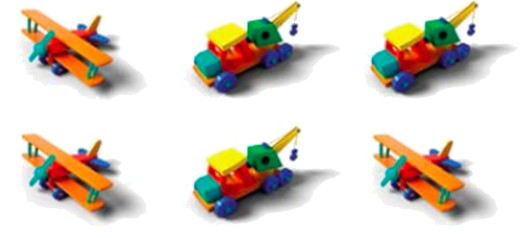C2.3 Identify and use equivalent relationships for whole numbers up to 50, in various contexts.
Activity 1: Exploration of Properties
Explore the Commutative Property
Example 1
Ask students to make a necklace by stringing 5 red beads and 2 blue beads, then suggest they write the corresponding number sentence.
5 + 2 = 7

Have students turn the necklace and write the corresponding number sentence.
2 + 5 = 7

Then suggest that students compare the two number sentences and answer the following questions:
- What do you notice about the order of the beads?
- What do you notice about the amount of beads?
- Why is the quantity the same in both cases?
- Change the amount of beads on the necklace and write two number sentences. Compare the number sentences. What do you notice?
- If you follow the same approach using a large amount of beads on the necklace, such as 100, 300, or 500, what can you say about the equality situations you observe?
Note: Repeat the activity, asking students to move to look at the necklace in the other direction instead of turning it.
Example 2
Ask students to determine if the number sentences below are true or false without performing any calculations.
\(\displaylines{\begin{align}6 + 3 &= 3 + 6 \\ 15 + 14 &= 14 + 16 \\ 7 + 19 &= 19 + 7 \end{align}}\)
After introducing each number sentence, ask students the following questions:
- How can you tell if this sentence is true or false?
- What do you notice about the terms in this equality?
Explore the Role of the Number 0 in Addition
Present students with six toys and ask them to count them. Cover the toys with a cloth and tell them that you will add a mystery number of toys.

Pretend to add toys, but do not add anything. Remove the cloth and ask the following questions:
- How many toys are there now?
- How many toys did I add?
Ask students to write a number sentence that represents the situation (6 + 0 = 6).
Repeat the activity, adding 6 toys to 0 toys to represent (0 + 6 = 6).
Point out to students that since 6 + 0 = 6 and 0 + 6 = 6, we can conclude that 6 + 0 = 0 + 6 and make the connection with the commutative property of addition.
Encourage students to propose a conjecture about the role of the number 0 in an addition, then ask questions such as:
- Could you apply your conjecture to other numbers? Try it out.
- Could you apply your conjecture to all numbers? Why?
Explore the Role of the Number 0 in Subtraction
Present 8 toys to students and ask them to count them. Cover the toys with a cloth and tell the students that you will remove a mystery number of toys.
Pretend to remove toys, but do not remove anything. Remove the cloth and ask the following questions:
- How many toys are there now?
- How many toys did I remove?
Ask students to write a number sentence that represents the situation (8 – 0 = 8).
Encourage students to propose a conjecture about the role of the number 0 in a subtraction, then ask questions such as:
- Could you apply your conjecture to other numbers? Try it out.
- Could you apply your conjecture to all numbers? Why?
Note: Parentheses are used to ensure mathematical accuracy. However, with elementary students, it is best to stick to less abstract ways of highlighting groupings.
Example

Activity 2: Using Strategies to Develop Algebraic Thinking
Add a Mystery Number
In pairs, ask each student to build a tower with six interlocking cubes and then ask them the following question: What do you notice when you look at the two towers? (The towers are the same height and the same number of cubes.)
Ask them to add any number of cubes to the towers, while making sure to keep the towers the same height.
Ask each team to explain how they maintained the same height. Then write their answers on a chart.
Example 1
| Group | Height of the Towers at the Beginning | Added by Student A | Added by Student B |
|---|---|---|---|
| 1 | 6 | 3 | 3 |
| 2 | 6 | 4 | 4 |
| 3 | 6 | 1 | 1 |
| 4 | 6 | 5 | 5 |
| 5 | 6 | 2 | 2 |
Ask students to analyze the data and draw their attention to the fact that the same amount must be added to each of the towers for equality to hold. Point out that this is true for all the quantities added.
Ask them to check if it is possible to add a quantity to a single tower and maintain equality. Point out that the equality is maintained only if nothing is added (0 cubes).
Have one member of each team add a cube to their tower, then ask students the following questions:
- What do you notice now as you look at the two towers? (The towers do not contain the same number of cubes; one more or one less depending on the situation)
- What do you need to do to restore equality?
Note: Students should be able to see the inequality and explain it before they try to restore equality.
Have one member of each team add two to five cubes to their tower, as desired.
Ask the other student to make the two towers equal.
Ask each team to explain how they made the towers equal. Point out to students that each team had to add the same amount of cubes to the second tower as they added to the first tower to make them equal. Draw their attention to the fact that this applies to all the quantities added.
Decompose Numbers According to Place Values
Introduce students to the number sentences below and ask them if they are true or false:
\(\displaylines{\begin{align}47 &= 40 + 7 \\ 35 + 12 &= 35 + 10 + 2 \\ 17 + 21 &= 10 + 20 + 7 + 1 \end{align}}\)
To encourage students to justify their answers, ask them the following questions:
- How can you tell if this mathematical statement is true (or false)?
- Is it possible to test for equality using concrete materials, such as ten frames, base ten materials, and interlocking cubes?
- How does this material help determine if the sentence is true or false?
- Is it possible to verify the equality without concrete materials and without doing any calculations? How? (By comparing the tens and ones on each side of the = sign, it is possible to check the equality without using concrete materials)
Balancing Terms or Expressions
Write the following number sentence: \(3 + 14 + 32 = 32 + 14 + 3\).
Ask students the following questions:
- Is \(3 + 4 + 32\) the same as \(32 + 14 + 3\)? How do you know? (Some students will use the commutative property.)
- If I remove the numbers 32 on either side of the = sign, does the equality remain true?
- If I remove the numbers 14 on each side of the = sign, does the equality remain true?
Example 2
Present students with the number sentences below and ask them to check whether they are true or false.
\(\displaylines{\begin{align}3 + 4 + 2 &= 3 + 3 + 2 \\ 5 + 6 + 8 &= 6 + 5 + 8 \\ 11 + 7 + 4 &= 5 + 6 + 7 + 4 \end{align}}\)
For each number sentence, ask students the following questions:
- Is this sentence true or false?
- If you remove terms that are the same on either side of the = sign, is the equality still true? How do you know?
Compare Terms
Present the following number sentences:
\(\displaylines{\begin{align}9 + 8 &= 10 + 7 \\34 + 17 &= 35 + 16 \\13 + 28 &= 16 + 25 \end{align}}\)
Ask students to check, using a double open number line, if these sentences are true.
For each sentence, ask students the following questions:
- How can you say that this sentence is true?
- What terms did you compare?
- What do you notice about these terms?
- Can you compare the terms in another way?
Source: translated from Guide d’enseignement efficace des mathématiques de la maternelle à la 3e année, Fascicule 2, Situations d'égalité, p. 101-108.
Activity 3: Representing Quantities to Understand Equivalence Relations
When numbers are decomposed, the sum of the parts is equivalent to the whole.
The various activities below lead students to understand that, even if the quantity is broken down in different ways, it remains the same. The concrete and visual (semi-concrete) representations can later be combined with a symbolic representation.
Example
\(\displaylines{\begin{align}50 &= 25 + 25 \\ 49 + 1 &= 1 + 49 \\ 20 + 20 &= 10 + 10 + 10 + 10 \end{align}}\)
Represent 40 by making different jumps on a number line or on a beaded line.
Mystery Number - Group students into pairs and invite them to represent a number in different ways (concrete or semi-concrete materials, symbols). Create a gallery where students circulate and see the different ways other teams have represented their number.
